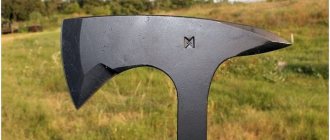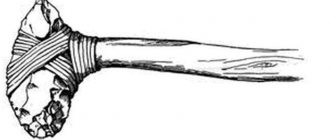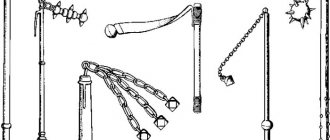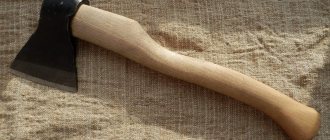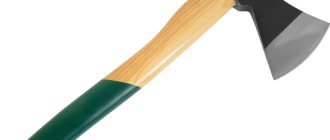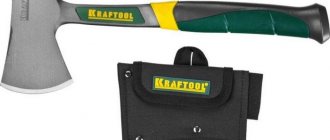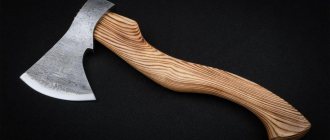Every person has long known that war is considered an invariable companion of progress. Man, throughout the history of the world, has constantly fought: he fought for land, livestock, women, money, faith and the Fatherland.
With the development of civilization, the equipment of warriors, their weapons, armor and protection gradually developed. Everything became more advanced and dangerous. Let's take a closer look at the weapons of medieval warriors, which have not lost their relevance to this day. The main character of this article is the axe.
History of creation
Ax - one of the types of battle axes is distinguished by a special blade in the shape of a crescent. Such weapons were common back in the 1st millennium in Ancient Greece, but from the Iberian Peninsula they quickly spread throughout the continent and became known not only in Europe, but also in Asia.
At that time, the ax had two blades located along the handle like a butterfly. Such a double-sided ax was capable of much in the hands of an experienced warrior; the long handle ended with a point, so it could both chop and stab.
The two-handed ax was very popular among infantry; it was intended for attacking horsemen and tearing metal armor.
Like a battle axe, the ax is a destructive weapon of enormous power, but it is lighter and, due to its long handle, has better balance, which gives the warrior the opportunity to maneuver during battle.
And although in our time there are various types of weapons of mass destruction, the popularity of battle axes has again risen due to their versatility, size and ability to be used in extreme conditions.
Ax with a wide blade
What is a broad ax? The broadaxe, also called a broadaxe, which literally means "broad axe" in English, is a tool used by carpenters. In the military environment, its use was limited.
This type of ax had a wide blade in the form of a trapezoid, a rectangular beard and a striker. The time of distribution of such axes is the X-XI centuries, the place is the Scandinavian countries and the Baltic states. The difference between these axes is the roundness of their blade. And also the fact that the space leading from the canvas to the butt was quite thin. Axes often had decorations in the form of inlaid silver.
As for finds on the territory of Ancient Rus', there are very few axes of this type, which is evidence of the rarity of their use. All of them date back to the 11th century. Broad-bladed axes preceded the appearance of reeds, which were already mentioned above. But there were also axes with a wide blade, which were used in military affairs. Let's take a closer look at them.
Distant ancestor of the battle ax
The ancestor of the battle ax was the two-edged labrys, which originated in Ancient Greece and is a symbol of divine power. The functions of these weapons were combat, religious, and ceremonial. Since it was very difficult to make such weapons, they were available only to kings and priests.
An ax with two blades arranged in a butterfly pattern on either side of the shaft required enormous strength and dexterity to use in battle. A warrior armed with a labrys and covered with a shield was invincible and, in the eyes of those around him, was endowed with divine strength and power.
Varieties
What is a broad-bladed ax used in battle? There were axes with one- and two-sided sharpening. The latter were mostly military weapons and were used very limitedly in everyday life. They were inconvenient for domestic use. It is noteworthy that during the period of New History and at a later time their purpose was to cut off heads. Thus, during executions, executioners “worked” with axes with a wide blade in Sweden from the 17th to the 19th centuries inclusive.
As for the axes, sharpened on one side, they were a working tool. Their use was of great convenience when processing large-scale surfaces, such as beams and bars. There were axes that had both right and left sharpening. According to archaeological data, such axes began to be produced in the 8th century, and they were popular in Denmark for a long time. Next, let's look at what the word “axe” means in mythology.
Forging an ax
As a rule, axes were forged in the following ways:
- High-quality weapons are forged from scratch, taking into account all the wishes of the future owner. Such weapons were quite expensive;
- Simpler weapons were forged from ordinary battle axes. At the same time, the blade was pulled back, giving it the shape of a crescent;
- The lowest-grade weapons were made from ordinary peasant axes. The quality of this weapon was very low, although its appearance could be the same as in the second case.
In any case, the ax was intended only for combat, so cutting down a tree, for example, was problematic.
Best two-handed gear in Skyrim
In truth, there are definitely some of the best weapons in the game, both one-handed and two-handed. Skyrim is a role-playing game, each item has a set of various parameters, characteristics, and improvements. This is especially true for items of equipment - armor and weapons, because such things can have magical enchantments and can also be improved at the forge.
In addition, a lot depends on what skills the Dovahkiin has developed. With some skill, you can even fight with your bare hands, and it’s great that the game gives you this opportunity.
Main characteristics
Forged axes consist of the following parts:
- Shaft;
- Blades;
- A butt, in the form of which a spike, a hammer or a second blade could often appear;
- A special counterweight on the opposite part of the shaft.
Such specific types of axes, such as halberds or reeds, were up to 2.5 meters long and were used only by infantry. Horse axes often had a spike on the back side, and their length was about 70-80 cm. The longest type of such weapon were boarding halberds, which were up to three meters long.
The blade of most types of such axes did not move far from the shaft, since otherwise balance was lost, which negatively affected the speed of wielding the weapon. Most models of these weapons had a two-handed grip and a long shaft, although in China there were very popular paired axes with a short shaft.
The length of the shaft depends on the method of use:
- Infantry - a shaft up to two and a half meters, the weapon was called “combat halberds”;
- Cavalrymen - a little less than a meter, “horse axes”;
- Boarders - up to three meters, “boarding halberds”.
A very interesting type of battle ax is the executioner’s ax. This weapon had features atypical for its class:
- The executioner's forged weapon had a huge weight - from 5 kg, which made it unsuitable for combat use;
- The steel that was used for the executioner's ax was of a higher quality, since the work had to be done with one blow.
In addition, the executioners had to have enormous strength, since some noble criminals were supposed to be executed with a sword, with which it was much more difficult to cut off their heads.
The most famous axes in our time are the two-handed Viking axes. Thanks to films, many people imagine that the Vikings all owned just such weapons. In fact, the most popular weapons of the Scandinavians were spears and one-handed axes weighing about 700 grams. Only the strongest fighters wielded a heavy forged axe. Often these were berserkers who relied only on strength in battle, completely rejecting defense.
Labrys
During excavations of palaces on the island of Crete, archaeologists found huge axes called “labryses”. Labryses are double-sided bronze battle axes of the ancient Greeks, which were also used in sacred ceremonies. They were also known to the Romans.
Labryses reached a length exceeding human height. Their carriers in Minoan culture (unlike the territory of the Middle East) were women - priestesses. Labrys axes were sacred symbols for them and were used to kill bulls during sacrifices. Labrys is shaped like a butterfly, which, according to researchers, symbolizes the feminine essence.
And also in the similarity of the word “labrys” with the word “labyrinth”, some of them see an association of this double-sided weapon with the labyrinth of the Knossos palace and the Minotaur. An ax was found, on which there is an image of a human head in front and profile with a zigzag comb. Today this labrys is exhibited in one of the Cretan archaeological museums.
Weapon versatility
The versatility of axes allows them to be used as spears. The difference can only be in length, and also in the fact that balanced axes cannot be used as spears.
Axes were used to pull warriors off their horses or strikes were struck in the area of the lower extremities, which were almost unprotected. So, for example, spears were used in defense, axes and swords in attack, while axes were used as a middle ground between these weapons. By the way, in some armies there were ax-bearers who defended the flanks; in the Russian army they were called spearmen.
Berdysh
This is a combination of an ax and a halberd. The chopping part is like the first one, but much larger, and the length is the same as the second one. Such a weapon was used most of all in Rus' and Eastern Europe. In the 14th century, the same reeds were used at the Battle of Kulikovo. The Slavs often fought off the Tatars and Poles with these weapons. In Russia it was a symbol of the Streltsy troops; in our country the berdysh was used for a very long time. This weapon was used only in second positions and beyond due to the inability to cover with a shield from arrows and insufficient length like spears.
Berdysh in the museum
Because of the blade and its weight, the reed easily cut down opponents and delivered cutting blows. But over time, the most popular weapon in Rus' lost its relevance. Such weapons will not be of much help against cavalry with spears. This weapon is used only by city guards.
The most famous types of axes
In different countries, axes looked different and were used, based on the shape of the blades, for different purposes. There are too many types of axes to count, but here are the most famous:
- Halberds;
- Berdyshi;
- Brodex;
- Lochaber axes;
- Armenian sacravores;
- Scandinavian axes;
- Polexes;
- Guizarms;
- Glaives;
- Indian "bhuji";
- Japanese "nagamaki" and "naginata";
- Chinese "guandao";
- Naturally Russian “owl”;
- And others.
How to get the Ax weapon of Wuuthrad
This thing is perfect for those who dream of settling scores with elves. Wuuthrad deals more damage specifically to the “eared” races, and the base indicator is also quite high - 25. This is a damn powerful ax!
The path to the Wuuthrad Ax lies through the Companions storyline. It will have to be completed completely, since only after the results of the last task, “Glory of the Dead”, Dovahkiin gets the opportunity to grab Wuuthrad with both hands.
Ax of Perun
In addition to the fact that the ax was an excellent weapon in battle, its shape was even used to make amulets. One of them was called “Perun’s axe” and was an ax with a pair of sharp blades attached to a small shaft. The ax was worn as a talisman on the chest or on the belt. Usually the material for the talisman was iron, bronze or lead.
In Slavic mythology, Perun was given the role of the god of thunder and lightning creator. He was revered as a symbol of the power of the prince and the patron of his squad. Perun was depicted as a black-haired, red-bearded, strong man who used a chariot, which was propelled by two winged stallions.
He used his constant attributes: lightning arrows, a spear, an ax and other weapons. Perun's ax was considered the most victorious weapon, which he used in countless battles. One legend tells of a battle with the Serpent, in which Perun managed to restore the presence of daylight with his weapon. Following these events, the ax began to be revered as the personification of victory.
Halberd
For a long time, gunsmiths tried to make weapons ideal for beginners in combat, easy to master and dangerous for enemies. A long weapon under 2 meters with a sharpened ax and a spear-like tip was ideal against combat with cavalry. The halberd is a universal weapon - you can stab and chop the enemy, and all this at a long distance. The invention or improvement of the German weapon - the halberd - is behind the doormen.
Various types of halberds
The halberd was first mentioned in 1287. The guns were used at the battles of Morgarten (1315) and Sempach (1386). Halberds stood in the third rows so that they could cut from above and stab over the shoulders of their comrades. The best place to strike with a halberd is at the feet. It is possible to deliver crushing blows against them without bending down and at a long distance, which is very good against horses due to the unprotected legs. But the halberd does a good job of breaking through enemy armor due to the enormous impact force and long tip. It is now possible to see a halberd in the Vatican - The guards defended the Pope with the help of halberds. Over the years, only the ax has changed with this weapon. At the beginning of creation it was convex, but from century to century it became straight.
Legendary Viking weapons
Normans, Vikings, Varangians - words that terrified all the peoples inhabiting Europe, since the world did not know more bloodthirsty and powerful warriors at that time.
Armed with Scandinavian axes, otherwise called Danish or heavy battle axes, the Vikings were never defeated in battle and always took rich booty and took captive slaves.
The main difference between this weapon was its wide, heavy blade, which could instantly cut off a person’s head or limbs. Mighty warriors masterfully wielded axes for battle, work, and tournaments.
In Kievan Rus, which had close trade ties with the Scandinavian countries, battle axes looked like siblings of the Viking axe. For the Russian foot army, axes and axes were the main type of weapons.
Distribution throughout Europe
This type of ax was invented in Scandinavia. As a result of the spread of Norman influence in the world in the 10th-11th centuries, it began to be used in such historical European regions as Normandy, England, and Ireland.
In the Russian lands, axes were adopted from the second half of the 10th century. They began to be used more intensively only in the 11th century in the northern part of Russian territory. Judging by the fact that they account for approximately a tenth of all finds, they were very popular. In Rus', axes ceased to be used somewhere in the 12th-13th centuries, but in other European countries, on the contrary, they became more and more widespread. At the same time, the ax undergoes improvement by increasing the length of the handle and adding spikes.
Later, it turns into a polex, which in the 15th-16th centuries became one of the most used types of weapons in foot combat, as well as in knightly tournaments. It has different shapes, sometimes it has heavy ax blades like a halberd, and sometimes heads that look like hammers with a curved spike at the back. At the same time, in Ireland and Scotland, Scandinavian axes continued to be used in the same form in the 16th century.
The best unique bows in Skyrim
A bow will be useful for almost every hero, but it is especially often used by those who, for certain reasons, do not want to “get their hands dirty” by waving all sorts of sharp things, like some savage or barbarian. There are plenty of bows in the game, but only 3 of them will serve Dovahkiin best: The Nightingale Bow, Glass Bow of the Stag Prince and Gauldur Blackbow.
How to get the Bloodskal weapon
Appeared in the game after the release of the Dragonborn add-on. This is a hefty two-handed sword that causes a magical explosion when hit hard. Even without taking into account the impressive physical damage, Blaskal is valued for the fact that the burst of energy deals 30 damage!
To become the owner of Blaskal, you need to start the storyline of the Dragonborn expansion, and then, having arrived on Solstheim, go to the Raven Rock Mine and take the side quest “The Final Descent” from a character named Krestius Carellius (Crescius Caerellius). The blade will lie near the remains of Gratian in a deep dungeon.
How to get the Nightingale Bow weapon
This weapon belongs to Karliah, a member of the thieves' guild and the protagonist's temporary companion during some quests. The Nightingale Bow enchant allows you to freeze and shock targets, which is often useful in various situations. This is also another weapon that depends on the character's level. You shouldn't take it too early, it's better to wait. For example, up to level 46. It is then that the Nightingale Bow will become as powerful as possible.
To convince Karliah to give up the bow, you will have to join the Thieves Guild and follow its storyline. This is a rather long path that will only end at the Blindsighted mission. The bow will be given to the character as a reward for completing the quest. By the way, Dovahkiin will also receive an “endless” master key (Skeleton Key), but who is interested in such trifles?
How to get Volendrung weapon
A war hammer of impressive size can seriously frighten an impressionable hero with its demonic relief. But his damage is much worse - 47! When struck, Volendrung not only easily breaks the strongest bones, but also increases stamina, which is very convenient for Dovahkiin, because to make a good swing with such a hammer, one’s own strength will clearly not be enough.
Obtaining Volendrung is associated with the quest “The Cursed Tribe”, which begins in the orc fortress Largashbur. Arriving there, the hero must help the local orcs cope with a bunch of problems and at the same time show himself in a favorable light in front of the Daedric prince Malacat.
How to get the Ax of Sorrow weapon
A Daedric prince named Clavicus Vile describes this weapon as "powerful enough to have a lot of fun." And this is pretty close to the truth - the Ax of Sorrow in its base version deals 22 damage and also burns the stamina of enemies. In addition, it can be improved at the forge if you have the appropriate skill.
The Ax of Sorrow can be obtained as a reward for completing the Daedric quest “A Daedra's Best Friend”. But before you move on to it, you should reach at least level 10. After Dovahkiin becomes strong enough, you need to find a character named Lod near the entrance to Falkreath. There will be many more funny and not so adventures.


